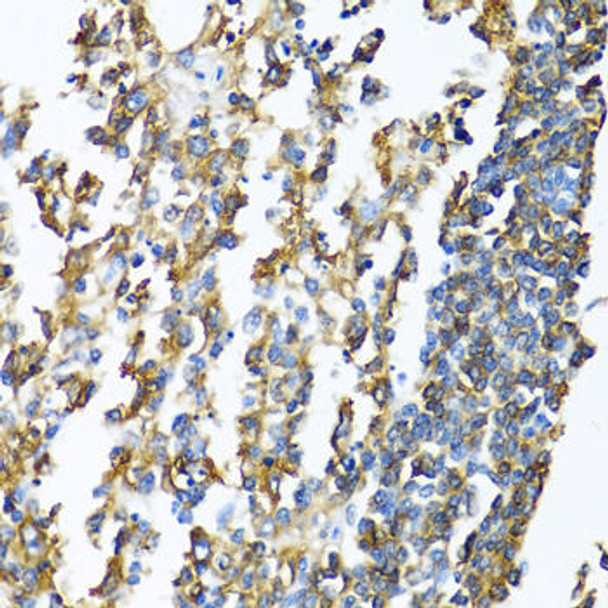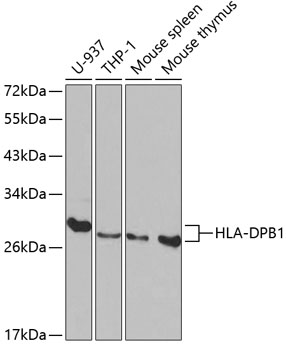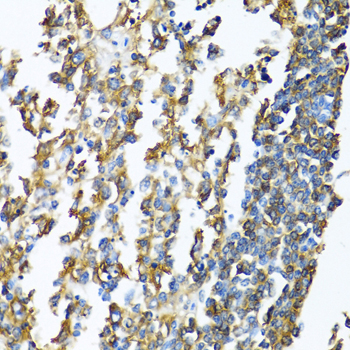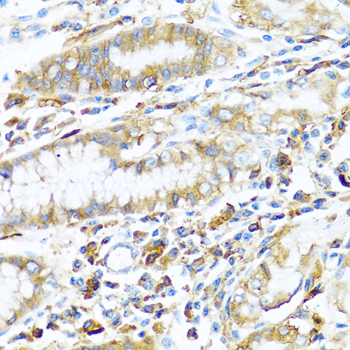Immunology Antibodies 1
Anti-HLA-DPB1 Antibody (CAB1412)
- SKU:
- CAB1412
- Product Type:
- Antibody
- Reactivity:
- Human
- Reactivity:
- Mouse
- Host Species:
- Rabbit
- Isotype:
- IgG
- Antibody Type:
- Polyclonal Antibody
- Research Area:
- Immunology
Description
| Antibody Name: | Anti-HLA-DPB1 Antibody |
| Antibody SKU: | CAB1412 |
| Antibody Size: | 20uL, 50uL, 100uL |
| Application: | WB IHC |
| Reactivity: | Human, Mouse |
| Host Species: | Rabbit |
| Immunogen: | Recombinant fusion protein containing a sequence corresponding to amino acids 30-225 of human HLA-DPB1 (NP_002112.3). |
| Application: | WB IHC |
| Recommended Dilution: | WB 1:500 - 1:2000 IHC 1:50 - 1:200 |
| Reactivity: | Human, Mouse |
| Positive Samples: | U-937, THP-1, Mouse spleen, Mouse thymus |
| Immunogen: | Recombinant fusion protein containing a sequence corresponding to amino acids 30-225 of human HLA-DPB1 (NP_002112.3). |
| Purification Method: | Affinity purification |
| Storage Buffer: | Store at -20'C. Avoid freeze / thaw cycles. Buffer: PBS with 0.02% sodium azide, 50% glycerol, pH7.3. |
| Isotype: | IgG |
| Sequence: | RATP ENYL FQGR QECY AFNG TQRF LERY IYNR EEFA RFDS DVGE FRAV TELG RPAA EYWN SQKD ILEE KRAV PDRM CRHN YELG GPMT LQRR VQPR VNVS PSKK GPLQ HHNL LVCH VTDF YPGS IQVR WFLN GQEE TAGV VSTN LIRN GDWT FQIL VMLE MTPQ QGDV YTCQ VEHT SLDS PVTV EWKA QSDS ARSK |
| Gene ID: | 3115 |
| Uniprot: | P04440 |
| Cellular Location: | Cell membrane, Endoplasmic reticulum membrane, Endosome membrane, Golgi apparatus, Lysosome membrane, Single-pass type I membrane protein, trans-Golgi network membrane |
| Calculated MW: | 29kDa |
| Observed MW: | 27-29kDa |
| Synonyms: | DPB1, HLA-DP, HLA-DP1B, HLA-DPB, HLA-DPB1, major histocompatibility complex, class II, DP beta 1 |
| Background: | HLA-DPB belongs to the HLA class II beta chain paralogues. This class II molecule is a heterodimer consisting of an alpha (DPA) and a beta chain (DPB), both anchored in the membrane. It plays a central role in the immune system by presenting peptides derived from extracellular proteins. Class II molecules are expressed in antigen presenting cells (APC: B lymphocytes, dendritic cells, macrophages). The beta chain is approximately 26-28 kDa and its gene contains 6 exons. Exon one encodes the leader peptide, exons 2 and 3 encode the two extracellular domains, exon 4 encodes the transmembrane domain and exon 5 encodes the cytoplasmic tail. Within the DP molecule both the alpha chain and the beta chain contain the polymorphisms specifying the peptide binding specificities, resulting in up to 4 different molecules. |
| UniProt Protein Function: | HLA-DPB1: Binds peptides derived from antigens that access the endocytic route of antigen presenting cells (APC) and presents them on the cell surface for recognition by the CD4 T-cells. The peptide binding cleft accommodates peptides of 10-30 residues. The peptides presented by MHC class II molecules are generated mostly by degradation of proteins that access the endocytic route, where they are processed by lysosomal proteases and other hydrolases. Exogenous antigens that have been endocytosed by the APC are thus readily available for presentation via MHC II molecules, and for this reason this antigen presentation pathway is usually referred to as exogenous. As membrane proteins on their way to degradation in lysosomes as part of their normal turn-over are also contained in the endosomal/lysosomal compartments, exogenous antigens must compete with those derived from endogenous components. Autophagy is also a source of endogenous peptides, autophagosomes constitutively fuse with MHC class II loading compartments. In addition to APCs, other cells of the gastrointestinal tract, such as epithelial cells, express MHC class II molecules and CD74 and act as APCs, which is an unusual trait of the GI tract. To produce a MHC class II molecule that presents an antigen, three MHC class II molecules (heterodimers of an alpha and a beta chain) associate with a CD74 trimer in the ER to form a heterononamer. Soon after the entry of this complex into the endosomal/lysosomal system where antigen processing occurs, CD74 undergoes a sequential degradation by various proteases, including CTSS and CTSL, leaving a small fragment termed CLIP (class-II-associated invariant chain peptide). The removal of CLIP is facilitated by HLA-DM via direct binding to the alpha-beta-CLIP complex so that CLIP is released. HLA-DM stabilizes MHC class II molecules until primary high affinity antigenic peptides are bound. The MHC II molecule bound to a peptide is then transported to the cell membrane surface. In B-cells, the interaction between HLA-DM and MHC class II molecules is regulated by HLA-DO. Primary dendritic cells (DCs) also to express HLA-DO. Lysosomal miroenvironment has been implicated in the regulation of antigen loading into MHC II molecules, increased acidification produces increased proteolysis and efficient peptide loading. Belongs to the MHC class II family. |
| UniProt Protein Details: | Protein type:Membrane protein, integral Chromosomal Location of Human Ortholog: 6p21.3 Cellular Component: Golgi membrane; cell surface; membrane; lysosomal membrane; plasma membrane; endosome membrane; trans-Golgi network membrane; MHC class II protein complex Molecular Function:peptide antigen binding Biological Process: positive regulation of interferon-gamma production; cytokine and chemokine mediated signaling pathway; T cell costimulation; antigen processing and presentation of exogenous peptide antigen via MHC class II; positive regulation of T cell proliferation; positive regulation of T cell activation; T cell receptor signaling pathway |
| NCBI Summary: | HLA-DPB belongs to the HLA class II beta chain paralogues. This class II molecule is a heterodimer consisting of an alpha (DPA) and a beta chain (DPB), both anchored in the membrane. It plays a central role in the immune system by presenting peptides derived from extracellular proteins. Class II molecules are expressed in antigen presenting cells (APC: B lymphocytes, dendritic cells, macrophages). The beta chain is approximately 26-28 kDa and its gene contains 6 exons. Exon one encodes the leader peptide, exons 2 and 3 encode the two extracellular domains, exon 4 encodes the transmembrane domain and exon 5 encodes the cytoplasmic tail. Within the DP molecule both the alpha chain and the beta chain contain the polymorphisms specifying the peptide binding specificities, resulting in up to 4 different molecules. [provided by RefSeq, Jul 2008] |
| UniProt Code: | P04440 |
| NCBI GenInfo Identifier: | 122263 |
| NCBI Gene ID: | 3115 |
| NCBI Accession: | P04440.1 |
| UniProt Related Accession: | P04440 |
| Molecular Weight: | 29kDa |
| NCBI Full Name: | HLA class II histocompatibility antigen, DP beta 1 chain |
| NCBI Synonym Full Names: | major histocompatibility complex, class II, DP beta 1 |
| NCBI Official Symbol: | HLA-DPB1 |
| NCBI Official Synonym Symbols: | DPB1; HLA-DP; HLA-DPB; HLA-DP1B |
| NCBI Protein Information: | HLA class II histocompatibility antigen, DP beta 1 chain |
| UniProt Protein Name: | HLA class II histocompatibility antigen, DP beta 1 chain |
| UniProt Synonym Protein Names: | HLA class II histocompatibility antigen, DP(W4) beta chain; MHC class II antigen DPB1 |
| Protein Family: | Myosin |
| UniProt Gene Name: | HLA-DPB1 |
| UniProt Entry Name: | DPB1_HUMAN |
View AllClose









